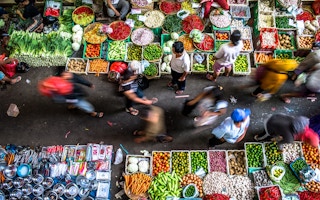“Poorly designed landfills can contaminate groundwater and emit GHGs (greenhouse gases) into the atmosphere,” said Nick Jeffries of the Ellen MacArthur Foundation, a nonprofit that works towards creating a global circular economy.
Landfill fires also affect human health, he added.
These dangers were all too apparent to Labde when he visited Bantar Gebang, where piles of garbage rise 50 metres into the air, and which officials say could reach maximum capacity within two years.
“All countries around the world are doing landfill as well but why are we the worst?” the 32-year-old asked as he sat in his fly farm’s office, which was cluttered with bags of dried maggots.
‘Out of sight, out of mind’
Opened in 1989, the Bantar Gebang dump used by Jakarta covers more than 81 hectares (200 acres) and is the capital’s only landfill and Southeast Asia’s largest.
Around 100 bulldozers and 800 people work on the massive site where 90 per cent of the city’s waste ends up.
Around 6,000 informal workers - sometimes accompanied by their children - also roam the soaring mountains of trash, searching for anything that has value to take to recycling sites outside.
During the dry season fires regularly break out, while rain during the monsoon can cause mounds of trash to collapse and spill outside the landfill’s boundaries.
Last year, Bantar Gebang took in 7,500 tonnes of waste per day, up from 6,400 tonnes in 2015, said a landfill official, who asked not to be named because they are not authorised to speak to the media.
Organic material, like food and garden waste, accounted for 50 per cent, plastics made up 23 per cent and paper 17 per cent, he said.
“In two years, if the condition is the same, we will reach our maximum capacity,” he told Context, adding that there was “no plan” in place if that happened.
There are about 2,000 recycling facilities in Jakarta and households are encouraged to separate their waste and use recycling collection points. But home collection services are few and businesses are responsible for managing their own waste, with some waste management firms illegally dumping trash.”
A government ban on single-use plastic bags in malls and street and wet markets in Jakarta is also poorly enforced.
Mohamad Bijaksana Junerosano is the founder and CEO of Waste4Change, which collects waste for a fee and takes it to four small recycling sites across the country, including one near Bantar Gebang.
Junerosano, who has about 15 years’ experience in the industry, said Jakarta’s waste issues were caused by lax enforcement of laws, a lack of public-private partnerships and a dearth of fair and proper financing arrangements for responsible waste management.
People in Jakarta have an “out of sight, out of mind” mindset on trash and with little enforcement, there were “no rules to the game”, said Junerosano.
“The minimum for us to be feasible, it’s like two cups coffee, 60,000 rupiah (US$3.87) per month per household,” he said, referring to how much it costs his company to collect a family’s trash.
“But the willingness to pay is only 20,000-30,000 rupiah.”
Talking trash solutions
In 2018, Indonesia generated 65.79 million tonnes of waste, 44 per cent of which was food waste, according to Mushtaq Memon, coordinator of chemicals and pollution action for Asia-Pacific at the UN Environment Programme.
Of that, 72 per cent was managed and 28 per cent unmanaged, with 69 per cent of the managed waste ending up in landfills and just 12 per cent recycled.
“With over half of Indonesia’s population residing in urban environments, waste management in cities is a critical issue for governments, industries and citizens,” Memon said.
Policies to encourage people to separate and sort their waste should be prioritised, food loss and waste should be reduced and scavengers should be trained and supported, he added.
“By providing training to waste pickers to identify and sort waste materials from each other, it is both possible to increase recycling rates and the quality of recyclable materials, as well as improve the incomes of waste pickers,” he said.
Labde has faced his own challenges in trying to become part of the solution. Magalarva has had to move premises three times already - twice because of complaints about the smell.
But the company has been at its current site for three years now, receiving food waste from a major milk producer, waste collection businesses, waste collection sites used by scavengers, a large wet market, and 200 households.
Orders coming in for their high-protein animal feed ingredient are 6 - 8 times current capacity, said Labde, adding that he hopes to expand when he has capital to do so.
“I love flies. What they’re doing with processing all the waste … I’ll always be grateful for them … it’s the circle of life.”
This story was published with permission from Thomson Reuters Foundation, the charitable arm of Thomson Reuters, that covers humanitarian news, climate change, resilience, women’s rights, trafficking and property rights. Visit https://www.context.news/.

















